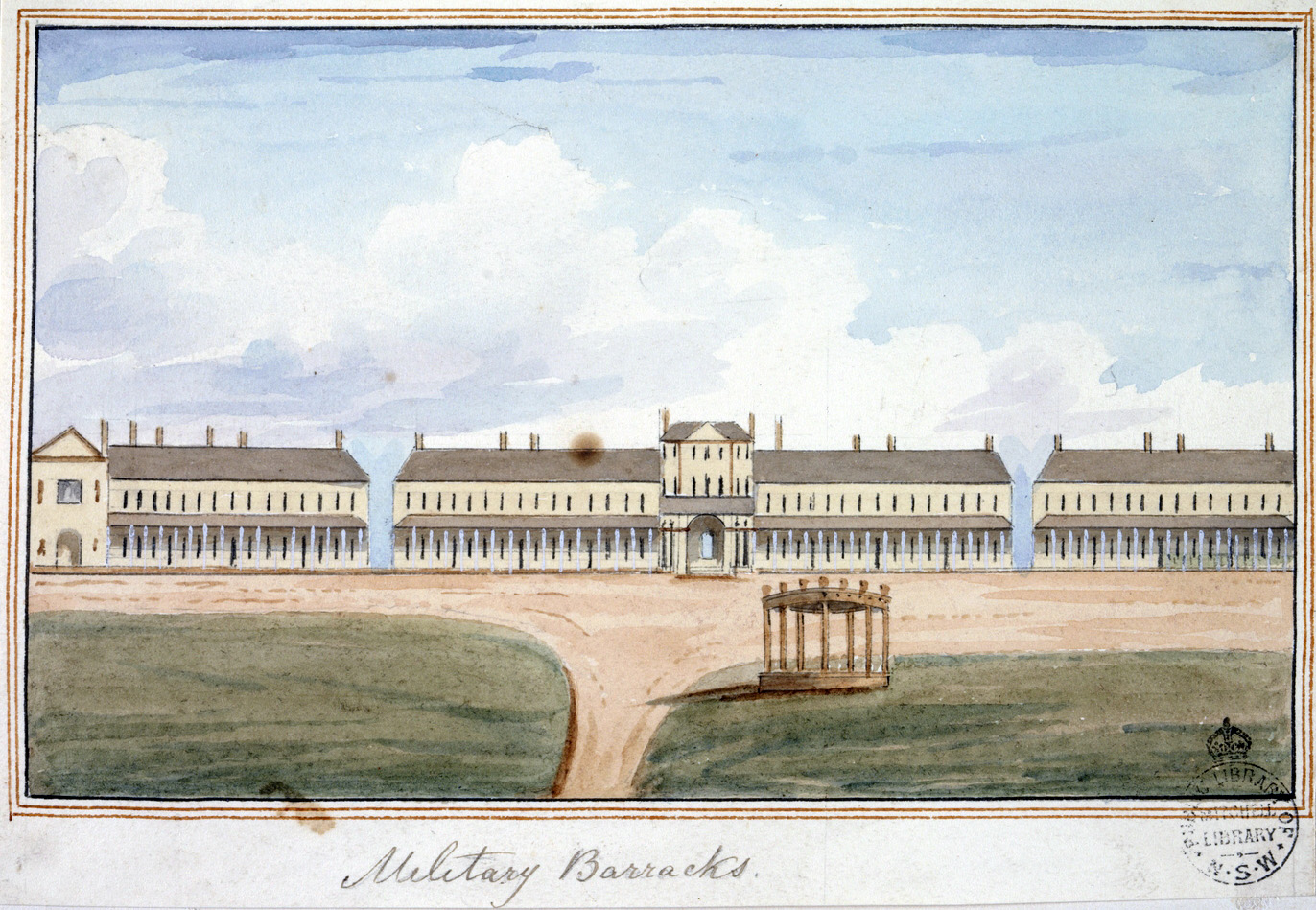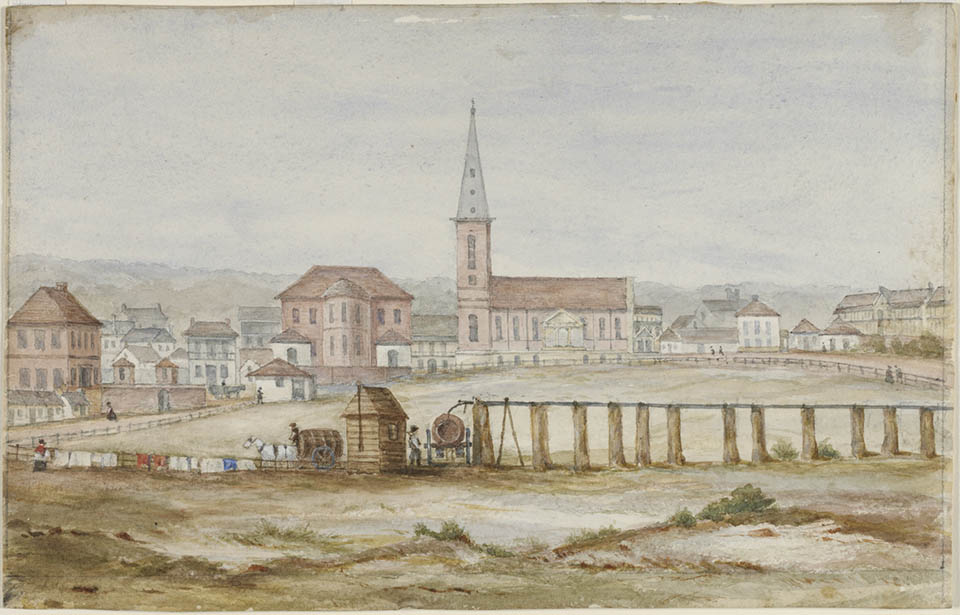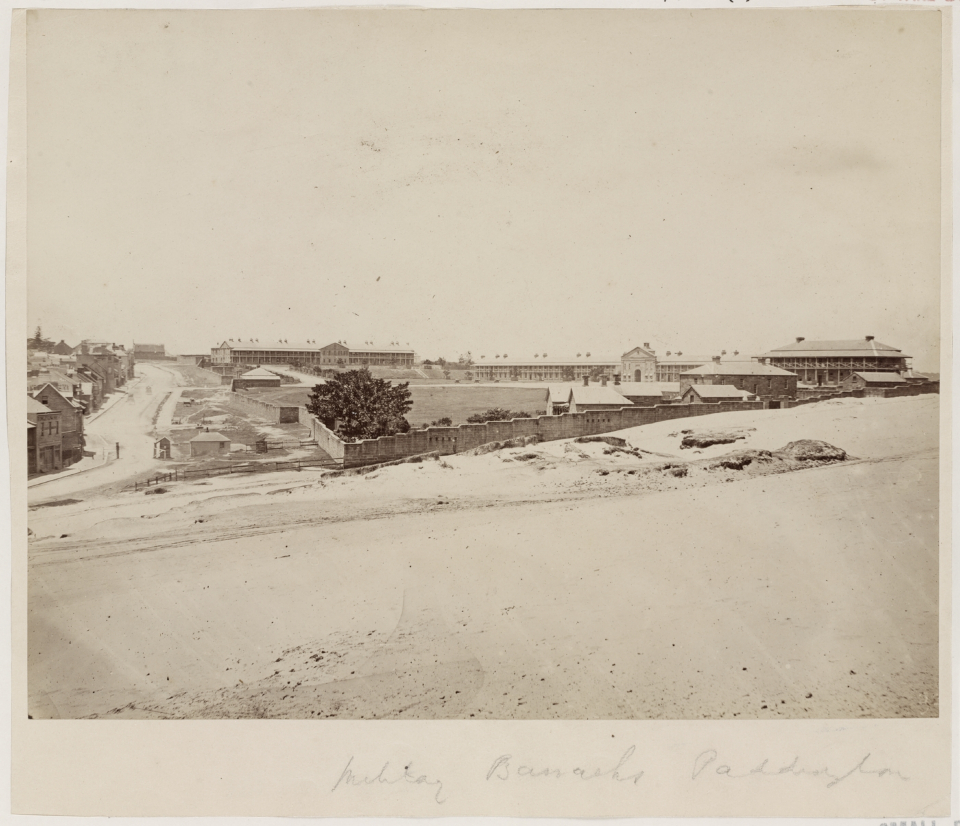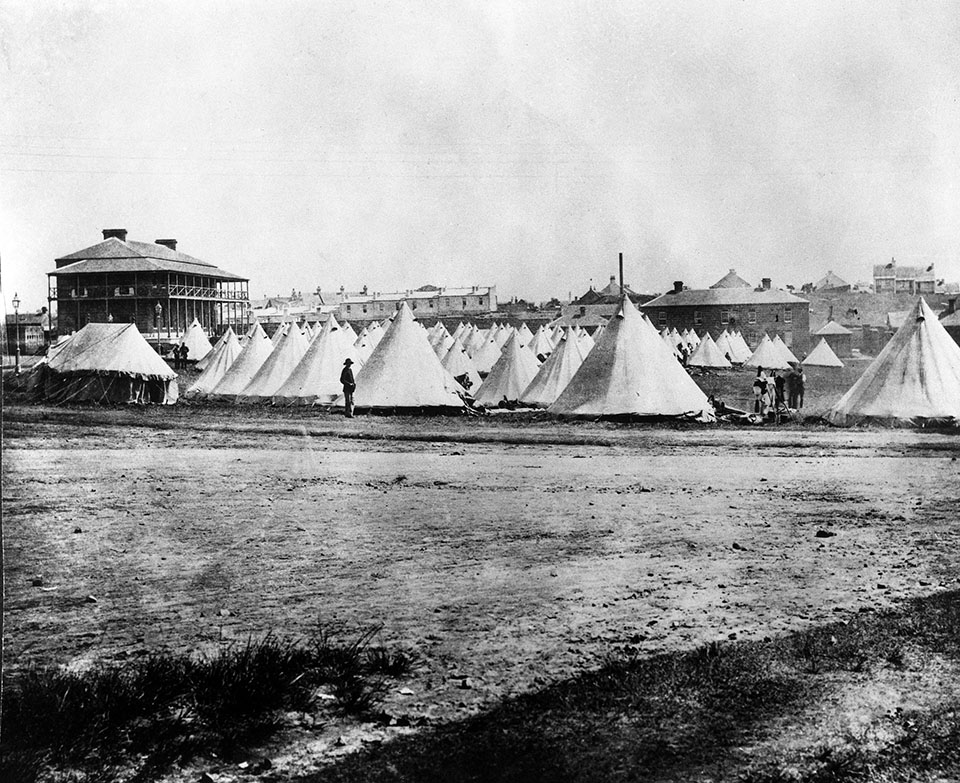The Dictionary of Sydney was archived in 2021.
Victoria Barracks
Citation
Persistent URL for this entry
To cite this entry in text
To cite this entry in a Wikipedia footnote citation
To cite this entry as a Wikipedia External link
Victoria Barracks
Victoria Barracks [media]in Paddington, built from 1841, was the third barracks built to accommodate military personnel in colonial Sydney. Having initially housed British regiments, it became home to colonial New South Wales units and in 2016 continues to provide accommodation for Australian military personnel.
George Street Barracks
The First Fleet included a detachment of Royal Marines to supervise the convicts, protect the settlement and generally keep order. Convicts constructed barracks for [media]the marines, which were next occupied by the New South Wales Corps, who replaced the Marines after the arrival of the Second Fleet in 1790. In 1792 the government built new barracks on a 16-acre (6.47 hectare) site on the western side of George Street, between what is now Barrack and Margaret streets, and extending west to Clarence Street.
When Governor Macquarie arrived in 1810 he considered many of the buildings to be dilapidated and unsuitable and ordered additional buildings. In 1815 the whole area was enclosed by a wall ten feet (3m) high, creating a virtual fortress in the heart of the town. The main gate on George Street gave access to the parade ground beyond which were the barrack buildings, along the western side of what is now York Street, As the town expanded it became obvious that the location of the barracks was impeding the commercial growth of the town and inhibiting planning and the laying down of streets. They also occupied a large area of land in a central position which was increasingly sought after and valuable.
In 1836 Governor Bourke decided to move the military to a new site on the outskirts of the town and asked the officers to recommend a suitable site. Their favoured site was the Cleveland Paddocks, the present Prince Alfred Park, on the southern edge of the town. Plans were drawn up but no progress was made. In 1840 the Paddocks site was deemed unsuitable because it was by then developing as a residential and commercial area.
The government settled [media]on an area on the South Head Road, the present Oxford Street. It was remote from the town centre, unsuitable for agriculture because of sand dunes and sandstone outcrops, which could be used for building material, and was close to Busby's Bore, the principal source of drinking water. The location on a high ridge line provided good strategic views in all directions. The area set aside was about the same size as that in George Street but adjacent vacant land offered opportunity for expansion.
The new barracks
Plans for the new barracks were drawn up by the Commander of the Royal Engineers, Major George Barney. There would be a main barracks building accommodating about 700 men, flanked on the east by quarters for 39 officers and on the west by a hospital for 50 patients, with ancillary buildings such as stables, kitchens and outhouses.
Construction began in 1841. Convict labourers cleared the site and quarried the sandstone while contracted masons did the actual building. The work was supervised by Barney and, from 1843, his successor, Lieutenant Colonel James Gordon.
By 1844, the east building (officers' quarters) had been completed and the foundations for the main barrack block were ready. The officers' quarters are considered to be 'the finest and most important officers' quarters and mess to be built in Australia during the nineteenth century … comparable to the best British military architecture of its epoch anywhere in the world.' [1] By 1848 the whole complex was ready for occupation and the George Street Barracks were decommissioned. Most of the land was sold for residential development, with a section facing York Street reserved as a public square named after Major General E B Wynyard, then the commander of British forces in the colony.
[media]During their construction, the new barracks were referred to as the South Head Road Barracks or the Paddington Hill Barracks but by 1844 they were being referred to as the Royal Victoria Barracks or just Victoria Barracks in honour of the reigning monarch. [2] Over time other buildings have been added to the site, and original buildings repurposed. The land area was increased in 1850 and now covers about 30 acres surrounded by a sandstone wall. The main entrance is from Oxford Street and the main building, the Barrack Block, 742 feet in length, is reputed to be the longest stone building in the Southern Hemisphere. Barney's buildings are considered to be 'the most significant and untarnished example of late Georgian architecture in Sydney’ and one of the finest example of colonial military architecture in Australia. [3] Morton Herman called it:
…a true museum piece of late Georgian architecture: a museum piece, moreover, that is in complete and active use – surely the ideal for any old building. [4]
The whole Barracks precinct is listed on the Register of the National Estate.
[media]The barracks housed various British Army regiments until 1870 when the colony became responsible for its own defence. The Barracks have been used continually since then by Australian forces. The first was the New South Wales Artillery, followed after Federation by various units of the Australian Army. Between 1931 and 1936 the Barracks housed the Royal Military College during the closure of its buildings in Canberra forced by the economic downturn of the Great Depression.
In 2016, the Army Museum of New South Wales occupies the former Military Prison building. Guided tours are held on a regular basis.
References
Kreckler, John F. The Story of Victoria Barracks: from Sydney Cove to Paddington Hill. Paddington: Army Museum Society, 1993.
Notes
[1] John F Kreckler, The Story of Victoria Barracks: from Sydney Cove to Paddington Hill (Paddington: Army Museum Society, 1993), 43–46
[2] Sydney Morning Herald, 19 April 1844, 3; Sydney Morning Herald, 16 May 1844, 3; Australian, 22 May 1844, 2
[3] Graham Jahn, Sydney Architecture (Sydney: Watermark Press, 1997), 33
[4] Max Dupain, Morton Herman, Marjorie Bernard and Daniel Thomas, Georgian Architecture in Australia with some examples of buildings of post-Georgian period (Sydney: Ure Smith, 1963), 35
.







